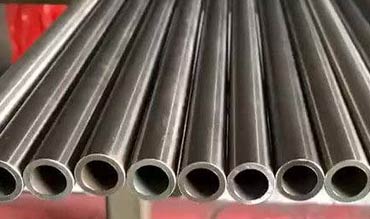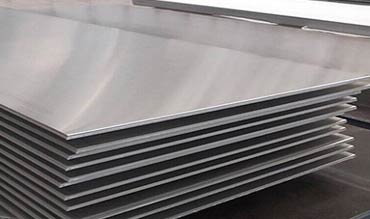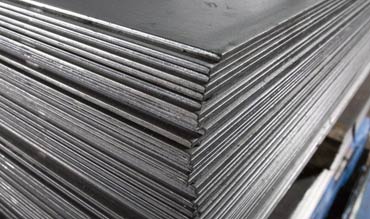Stainless Steel

Hastelloy
Stainless steel is an alloy of Iron with a minimum of 10.5% Chromium. Other elements such as Nickel, Molybdenum, Titanium, Aluminum. Niobium, Copper, Nitrogen, Sulfur, Phosphorus or Selenium, may be added to increase corrosion resistance to specific environments, enhance oxidation resistance, and impart special characteristics.
Shah International supplies the below Stainless Steel Grades : Hastelloy B-2 Stainless Steel SMO 254, Stainless Steel 304/304L, Stainless Steel 310, Stainless Steel 316/316L, Stainless Steel 317, Stainless Steel 321, Stainless Steel 347, Stainless Steel 904L, Stainless Steel AL-6XN

SMO 254
UNS Number S31254
SMO 254 is a very high end, molybdenum and nitrogen alloyed super austenitic stainless steel with low carbon content. It demonstrates outstanding resistance to pitting, crevice corrosion stress cracking, and corrosion fatigue uniform corrosion. Alloy 254 SMO is substantially stronger than the common austenitic grades, with strength nearly twice that of 300 series stainless steel. It is also characterized by high ductility and impact strength. With high levels of chromium, molybdenum, and nitrogen, Alloy 254 SMO is frequently used in high chloride environments, such as brackish water, seawater, pulp mill bleach plants, and other chloride process streams. In some applications it has even been found to be a more cost effective substitute for high nickel and titanium alloys.
Characteristics of Hastelloy B-2:
- Has a very low carbon content, which means there is very little risk of carbide precipitation during heating
- Possesses very good resistance in water containing chlorides, therefore, it is suitable for use in seawater as it can be exposed to it for prolonged periods without suffering from crevice corrosion
SMO 254 Chemical Composition, %
| C | Cr | Cu | Mn | Mo | N | Ni | P | Si | S | Fe |
| 0.02 max | 19.5-20.0 | 0.5-1.0 | 1.0 max | 6.0-6.5 | 0.18-0.20 | 17.5-18.0 | 0.03 max | 0.80 max | 1.01 max | Balance |
SMO 254 ASTM Specifications:
| Smls Tube & Pipe | Welded Tube & Pipe |
Bar |
Forging |
Fitting |
A269, |
A249, |
A276 |
A473 |
A182 |
Mechanical Properties of SMO 254:
Annealed Material
Tensile Strength |
98600 psi or 680 Mpa |
Yield |
(0.2 % offset) |
Elongation at break |
50 % |
Stainless Steel 304/304L
UNS Number S30400/S30403

Stainless Steel 304 is a T 300 Series Stainless Steel austenitic. It has a minimum of 18% chromium and 8% nickel, combined with a maximum of 0.08% carbon. It is defined as a Chromium-Nickel austenitic alloy. Grade 304 is the standard "18/8" stainless that you will probably see in your pans and cookery tools. Grade 304L, the low carbon version of 304, does not require post-weld annealing and so is extensively used in heavy gauge components (over about 6mm).
Stainless Steel 304 Chemical Composition, %:
C |
Mn |
Si |
P |
S |
Cr |
Ni |
N |
Fe |
0.08 max |
2.0 max |
0.75 max |
0.045 max |
0.030 max |
18.0-20.0 |
8.0-10.5 |
0.10 |
Balance |
Stainless Steel 304L Chemical Composition, %:
C |
Mn |
Si |
P |
S |
Cr |
Ni |
N |
Fe |
0.03 max |
2.0 max |
0.75 max |
0.045 max |
0.030 max |
18.0-20.0 |
8.0-12.0 |
0.10 |
Balance |
Application of Hastelloy B-3:
- Domestic tools industry
- Architectural panelling, railings & trim
- Heat Exchangers
Mechanical Properties of Stainless Steel 304/304L:
At Room Temperature
|
Stainless Steel 304 |
Stainless Steel 304L |
Tensile Strength |
515 Mpa min |
485 Mpa min |
Yield |
(0.2 % offset) |
(0.2 % offset) |
Elongation (in 50mm) |
40 % min |
40 % min |

Stainless steel 310
UNS Number S31000
Stainless steel 310 is an austenitic heat resistant alloy with excellent resistance to oxidation under mildly cyclic conditions through 2000°F. Its high chromium and nickel contents provide comparable corrosion resistance, superior resistance to oxidation and the retention of a larger fraction of room temperature strength than the common austenitic alloys like Type 304. Stainless 310 is often used at cryogenic temperatures, with excellent toughness to -450°F, and low magnetic permeability.
Application of Hastelloy C-4:
- Heat Exchangers
- Radiant Tubes
- Muffles, retorts, annealing covers
- Coal gasifier internal components
Stainless Steel 310 Chemical Composition, %:
C |
Mn |
Si |
P |
S |
Cr |
Ni |
Mo |
Cu |
Fe |
0.25 max |
2.0 max |
1.5 max |
0.045 max |
0.03 max |
24.0-26.0 |
19.0-21.0 |
0.75 max |
0.5 max |
Balance |
Mechanical Properties of Stainless Steel 310::
Tensile Strength |
515 Mpa min |
Yield |
(0.2 % offset) |
Elongation (in 50 mm) |
40 % min |
Stainless Steel 316/316L
UNS Number S31600 / S31603

Stainless Steel 316 is the standard molybdenum-bearing grade, second in importance to 304 amongst the austenitic stainless steels. The molybdenum gives 316 better overall corrosion resistant properties than Grade 304, particularly higher resistance to pitting and crevice corrosion in chloride environments. It has excellent forming and welding characteristics. It is readily brake or roll formed into a variety of parts for applications in the industrial, architectural, and transportation fields. Grade 316 also has outstanding welding characteristics. Post-weld annealing is not required when welding thin sections. Grade 316L, the low carbon version of 316 and is immune from sensitisation (grain boundary carbide precipitation). Thus it is extensively used in heavy gauge welded components (over about 6mm). The austenitic structure also gives these grades excellent toughness, even down to cryogenic temperatures.
Stainless Steel 316 Chemical Composition, %:
C |
Mn |
Si |
P |
S |
Cr |
Mo |
Ni |
N |
0.08 max |
2.0 max |
0.75 max |
0.045 max |
0.03 max |
16.0-18.0 |
2.0-3.0 |
10.0-14.0 |
0.10 max |
Stainless Steel 316L Chemical Composition, %:
C |
Mn |
Si |
P |
S |
Cr |
Mo |
Ni |
N |
0.03 max |
2.0 max |
0.75 max |
0.045 max |
0.03 max |
16.0-18.0 |
2.0-3.0 |
10.0-14.0 |
0.10 max |
Mechanical Properties of Stainless Steel 316/316L:

